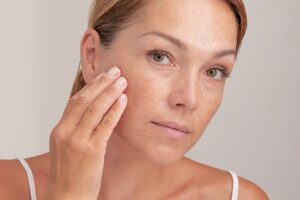 At KMP Aesthetics, many of our patients share stories with us about their long tropical vacations, SeaFair yacht parties, and European summers. Even younger patients tell us about their high school years in the tanning booth, Junes through Augusts spent wakeboarding without SPF, and how they used to “lay out” with their friends by the pool or on docks. Ah, the ignorant bliss of our youth that carries into adulthood!
At KMP Aesthetics, many of our patients share stories with us about their long tropical vacations, SeaFair yacht parties, and European summers. Even younger patients tell us about their high school years in the tanning booth, Junes through Augusts spent wakeboarding without SPF, and how they used to “lay out” with their friends by the pool or on docks. Ah, the ignorant bliss of our youth that carries into adulthood!
After hearing so many patients talk about their misinformed beliefs—the myths they’ve probably absorbed and parroted—about the sun, we decided it was time to offer a dose of reality. Keep reading to learn how to treat your skin well, even when you’re working to combat the infamous PNW vitamin D deficiency. Welcome to our deep dive into your skin myths vs. reality, sun edition!
Skin Myth:
Since I’m 50+, all the damage I’ve caused with long periods of sun exposure over the years (creping skin, pigmentation, deeply etched wrinkles, leathery rough skin) is permanent.
Reality:
Often, when patients first hear how strongly we feel about the sun, they worry that we can’t help them. Every situation is unique, and in this case, we can usually offer good news.
Patients are often elated to hear that they can visibly correct most short-term signs of aging from years of UV exposure by practicing complete sun avoidance and by implementing sun protective behaviors for 1-2 years. What do sun protective behaviors include, you may wonder? We thought you’d never ask!
What Are Sun Protective Behaviors?
Sun protective behaviors include staying out of the sun as much as possible, especially avoiding 10 a.m. – 2 p.m. when the UV index is highest, covering your skin and eyes when in the sun with clothing like sun shirts, gloves, hats, and glasses, and staying in the shade.
Even if you’ve spent years baking your skin under UV rays, at around 9-12 months of sun avoidance, even people in their 60s see less overall pigmentation; fewer fine lines; fewer deep-etched lines; softer, more plush skin; and less visible vascular damage (broken capillaries).
At around 18-24 months of complete sun avoidance, patients continue to experience visible rejuvenation of their skin. This rejuvenation can be hastened through the addition of a well-thought-out care plan, including treatments like laser resurfacing, light treatments (like our Forever Young BBL™ Treatment), neuromodulators (BOTOX® Cosmetic and DAXXIFY™), and filler (JUVÉDERM VOLBELLA® XC, RHA® Hyaluronic Acid Fillers).
Many patients think the above-noted treatments can absolve all their sun sins, as it were, and to the belief that we can solve skin issues caused by a vacation spent in the close company of our favorite yellow star with a few needles and lasers, we say FALSE.
Though the procedures offered at KMP Aesthetics are cutting edge and executed with the highest degree of skill found in the cosmetic dermatology industry, they often meet an intersection point with the patient’s lifestyle choices where their results won’t produce the duration or complete correction of skin concerns they once did.
Patients, please take note: As our skin ages, so does its ability to repair itself. Adding UV exposure throughout the year hastens this DNA repair degradation.
We encourage all patients to deeply consider the most effective and least expensive aesthetic treatment: Long-term and complete sun avoidance.
Clinical observation consistently shows that even the most dedicated aesthetic procedural patient will become frustrated with the duration and efficacy of their results if they continue heavy sun exposure—or even consistent moderate sun exposure.
Thread lifts will stop getting that last bit of creping on your neck or jowl, BOTOX® Cosmetic and DAXXIFY™ will stop getting the etched line post-treatment (even with increased dosing and expert application), and even RHA® Hyaluronic Acid Fillers will have a harder time correcting superficial concerns like tissue paper smile lines.
Worse yet, over very long periods of constant exposure, the skin becomes so disorganized in its structure that it adds to the laxity of the jowl fat pad. The industry term for this phenomenon is “The Terminal Event of The Aging Face.” Sounds pretty awful, right?
Not even face lifts will grab that superficial creping tissue in most cases—unless (you know where we’re going with this by now, don’t you?) you discontinue your sun routine.
Now that we’ve gotten you out of the sun for good, let’s dig into the next belief.
Skin Myth:
Once I fix my skin issues with laser and light therapy, I can continue my habits, and my brown spots, spider veins, wrinkles, and etched lines will be a thing of the past.
Reality:
Whether you’re seeing brown spots (solar lentigines) or spider veins (telangiectasias, rosacea), your DNA is damaged from the sun and is “reprogrammed” to auto-protect itself when faced even with a lower dose of the offending agent (in most cases, UV light).
Time adds up even in the best cases with driving, and walking to work—even with SPF, a sun shirt, and a hat and glasses. Those little frenemies are sure to need retreatment at least 1-2 times per year after your initial series.
Skin Myth:
They say it’s healthy to get a little bit of sun for vitamin D. So I put on SPF and go out for hours at a time during the summer. We get less sun than most places in the world in the PNW, so I deserve it.
Reality:
Bone health is the only evidence-based benefit for vitamin D and dietary intake can take care of that.
The other indicators that people reference to justify their destructive sun behavior like mood, immune system, cardiovascular disease, and autoimmune disease have no consistent evidence and are not supported by any current dermatological guidelines.
Additionally, the high risk of skin cancer (melanoma is the worst offender in the skin cancer category) and the inconsistent production of vitamin D from person to person lead the American Academy of Dermatology (AAD) to recommend that all people—regardless of their genetic heritage—get minimal to no sun exposure.
Skin Myth:
If I’m wearing SPF, I should be fine out in the sun for a few hours. My makeup has SPF in it.
Reality:
Just like a car’s airbag deploys when we get into an accident, topical SPF should be the last line of defense for your skin when it comes to the sun.
Before that, you must actively practice sun avoidance and sun-protective behaviors. If we’re following our car analogy, these behaviors can be compared to paying attention behind the wheel, not texting and driving, wearing your seatbelt, checking your tire pressure, and keeping your gas tank full.
You’re Done With The Sun: Now What?
There’s no need to beat yourself up about past bad behavior. As they say, When you know better, you do better. This blog is intended to educate you about how much havoc the sun wreaks on your skin, what you can do to prevent further damage, and some of the stories you may be telling yourself to continue to bake your body’s biggest organ under unforgiving (and more intense by the day) rays.
If you care about your skin’s future, you’ll heed our insights into the sun’s reality. As we mentioned, though, if you’re practicing sun avoidance activities and have some legacy damage, we are happy to talk to you during a consultation about what’s possible for you—and your skin.

